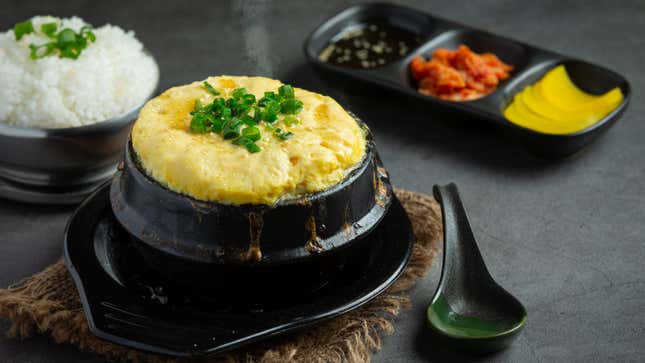
If you’re a fan of eggs, then you know how many forms they can take and how many ways you can use gadgets to prepare them. But amidst all the noise, there’s one egg preparation that’s not to be missed: gyeran-jjim, one of my favorite Korean banchan dishes.
The term literally translates to “steamed egg,” because that’s exactly what it is: steamed eggs in a bowl. If you find it at a restaurant, it’s usually served in a ttukbaegi, which is the same earthenware bowl you’re served soups and stews in. Whenever it appears on a menu, you must add it to your order.
What is gyeran-jjim?
In some restaurants you can order it as a side or appetizer, but sometimes gyeran-jjim is a default banchan that just shows up at your table along with kimchi and other small side dishes. It’s one of my favorite Korean dishes specifically because it’s so simple. It’s just eggs, fish broth (or plain water), fish sauce or shrimp paste for seasoning, then a little garnish of green onions and sesame seeds.
The result is a really fluffy custard that I recommend you eat piping hot, as it’ll deflate slowly as it cools off—though it’s no less delicious once it’s flatter. Gyeran-jjim’s texture is as much of a delight as is its lightly eggy flavor; it’s smooth and pillowy and practically melts in your mouth. The taste is savory with a very delicate hint of seafood, and with a bowl of sticky rice, kimchi, and maybe one extra banchan of your choice, you’ve got a full meal right in front of you.
How to make gyeran-jjim at home
This is a common dish in Korean households because of its ease of preparation. It can be steamed in a bowl placed in a steamer, cooked right on a stovetop, or even microwaved (which is how my mom makes it!).
This TikTok video from @pettykoreanmom features a pretty standard version of stovetop gyeran-jjim. She uses plain water instead of fish broth, and as you can see, prep only involves stirring eggs and mixing them with the rest of the ingredients. She makes hers right on the burner, and it only takes 15 minutes to cook. The prep work and cleanup couldn’t be any easier.
If you’ve been curious about Korean cooking at all, this is definitely an entry-level dish that’s about as easy as it gets, and you can get all the ingredients in most supermarkets. I encourage you to give it a crack (get it?) if you want to try your hand at some delicious home cooking.